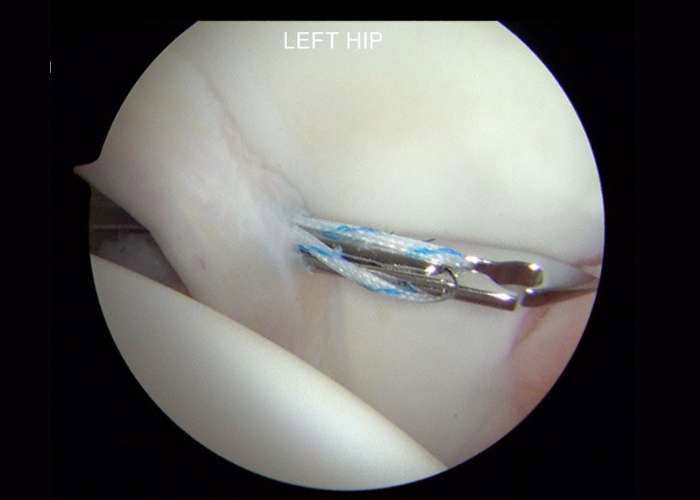What is a hip labrum tear?
The hip is a complex ball-and-socket joint, formed from the head of the femur (thigh bone) fitting snugly into a portion of the acetabulum (pelvis). A hip labrum is a fibrocartilaginous tissue that surrounds the socket, creating a seal between the head of the femur and the pelvis. The hip labrum is responsible for stabilizing the hip by deepening the socket and limiting movement of the femoral head, keeping it in place. The labrum is also a shock absorber which distributes weight evening throughout the joint. If the hip labrum tears, hip instability occurs, causing pain and often, hip dislocation. Dr. Leslie B. Vidal offers both conservative and surgical treatment options for patients in Vail, Eagle and Summit County and those in the surrounding Denver area who have torn their hip labrum.
What is the treatment for a hip labrum tear?
Conservative therapies may be sufficient at resolving symptoms of a small hip labrum tear or frayed hip labrum. Avoiding weight-bearing, or weight-bearing with the assistance of crutches, is encouraged. Non-steroidal anti-inflammatory medications (NSAIDs) and corticosteroid injections directly into the hip can be used for pain and inflammation management. A physical therapy program aimed at improving hip strength and mobility is highly encouraged for patients that want to avoid surgery.
However, when conservative therapy is unsuccessful, or in the event of a complex or severe hip labrum tear, surgical intervention may be required. The goal of surgically treating a hip labrum tear is to restore the original function of the hip labrum to restabilize the hip joint. Several factors, such as the patient’s age, medical history, activity level, injury severity, and recovery goals are considered when formulating an appropriate treatment plan. Dr. Leslie B. Vidal, orthopedic hip doctor, treats patients in Vail, Eagle, and Summit County, and those in the surrounding Denver area, who have experienced a hip labrum tear and are in need of surgery.
How is a hip labrum repair performed?
Patients with a small hip labrum tear or minor hip labrum damage from an injury are good candidates for a hip labrum repair. This minimally invasive procedure involves a small camera (arthroscope) and specialized surgical instruments to conduct the necessary repairs. Prior to starting, the patient is placed under general anesthesia. Once stabilized, Dr. Vidal creates a number of small incisions surrounding the hip joint. The arthroscope is inserted through a portal and the images are relayed onto a screen for Dr. Vidal to methodically examine the bones, ligaments, and cartilage of the hip joint. To enhance the visualization of these hip joint structures, a sterile solution is circulated continuously. The damaged hip labrum fragments are excised and removed through a process known as debridement. Any irregularities, such as bone spurs, that can irritate the tissue or disrupt the recovery process are also removed. The remaining healthy hip labrum tissue is reattached to its original anatomical position on the labrum. Special surgical anchors that are secured within the bone are used to fasten the repaired hip labrum.
On occasion, a complex or severely damaged hip labrum may not be responsive to debridement or repair. In such an event, a tissue graft from either the patient (autograft) or donor (allograft) is implemented to reconstruct the hip labrum. The tissue graft is measured to fit within the acetabulum socket and then fastened to the native tissue with special surgical anchors secured within the bone. The new tissue is inspected to verify a continuous seal between the head of the femur and the tissue graft. By reconstructing the hip labrum, the original suction seal function is restored to improve hip joint stability.
What is the recovery period like after hip labrum surgery?
The recovery period after hip labrum surgery is dependent upon the severity of injury and the surgical technique implemented. A patient’s willingness to comply with the post-operative care instructions provided by Dr. Vidal can also affect the recovery process. Most patients can expect a full recovery with a return to normal daily and sporting activities in approximately 6 to 8 months. Patients in the Denver, Colorado area can typically expect assisted weight-bearing with crutches for at least 2 weeks. A hip brace may be supplied to further protect the hip labrum while sleeping. A combination of ice and non-steroidal anti-inflammatory medications (NSAIDs) is encouraged for pain and inflammation management. Dr. Vidal may prescribe stronger pain medication to be taken as directed. The key to a successful recovery is active participation and completion of the physical rehabilitation program set forth by Dr. Vidal. This physical therapy program will focus on improving the strength and function of the hip.
In the video below, you can see Dr. Vidal’s arthroscopic repair of a hip labrum:
During a hip labrum repair:
Dr. Vidal visualizes the labrum with a small surgical camera called an arthroscope. The damaged tissue is cleaned up (debridement) and smoothed to create an even surface. The bone is also smoothed, as necessary. The labrum is then repaired with strong surgical sutures using specialized instruments.
Hip Labrum Repair Surgeon
Repetitive pivoting or twisting motions, often seen in ballet, golf, hockey, soccer or downhill skiing, can cause excessive wear and tear to the hip labrum. A labral tear often does not cause symptoms. However, if you are experiencing pain in the hip or groin, or a locking sensation with stiffness, you may need a hip labrum repair or reconstruction. Hip labrum surgeon, Doctor Dr. Leslie Vidal provides diagnosis and both surgical and nonsurgical treatment options for patients from Vail, Eagle and Summit County, and those in the surrounding Denver area, who are experiencing symptoms associated with a torn hip labrum. Contact Dr. Vidal’s team today!


